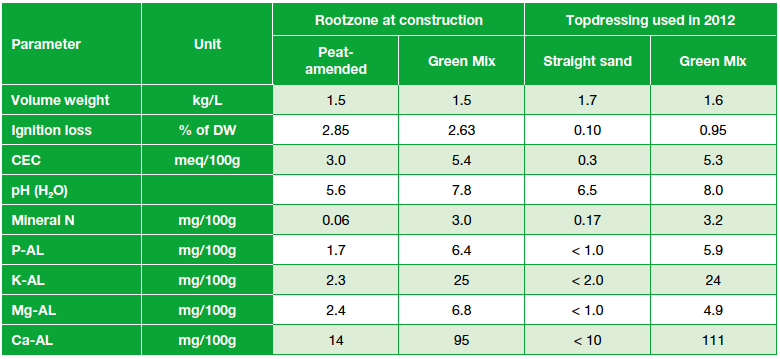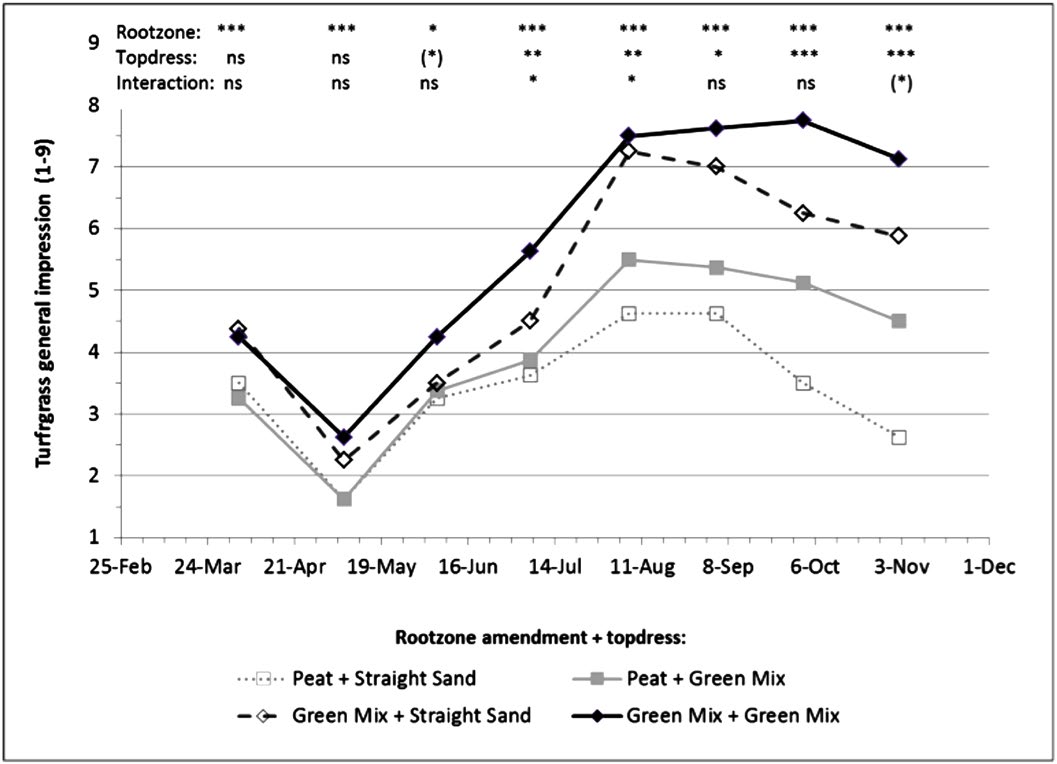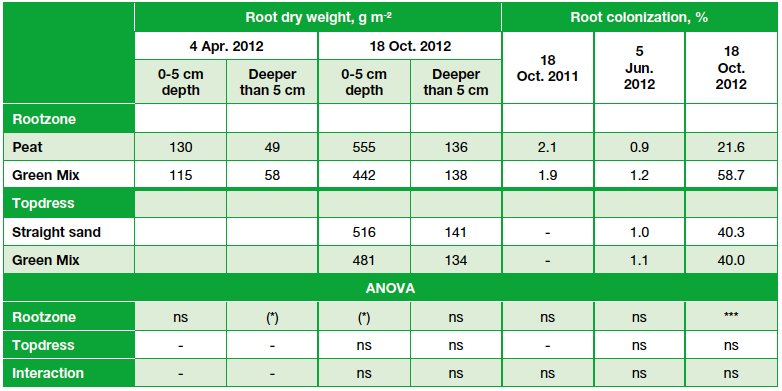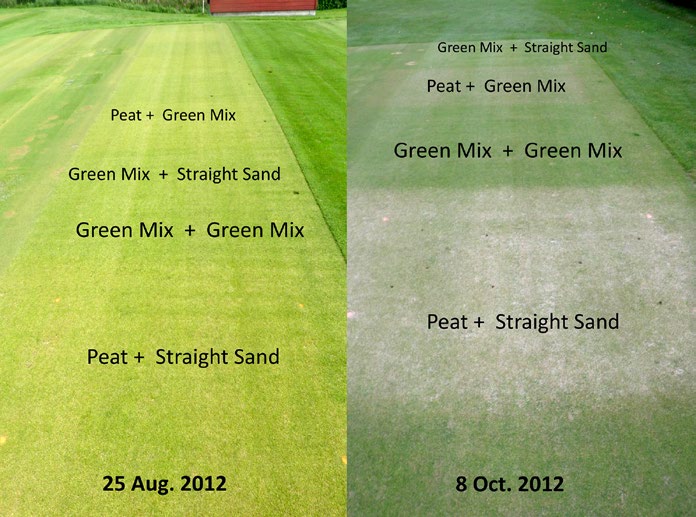Composted garden waste in rootzone and topdress on sand-based golf greens
Aamlid 1), T.S., T.E. Andersen 2), A. Kvalbein1, T. Pettersen1 and A.M. Dahl Jensen 3)
Zusammenfassung
Ziel dieses Forschungsprojekts war die Beurteilung der Auswirkungen kompostierter Gartenabfälle (Handelserzeugnis „Green Mix“, GM) in einer nach USGA spezifizierten Rasentragschicht und/oder dem Topdressing während der Einwachsphase und der Pflege eines jungen Golfgrüns, wobei eine Rotschwingel-Monokultur erzielt werden sollte. Von August 2011 bis November 2012 wurde am NIBIO Landvik Turfgrass Research Centre in Norwegen ein Feldversuch durchgeführt. In einer Versuchsplanung mit vier Wiederholungen wurden die GM-Wurzelbereiche mit solchen verglichen, bei denen Torf zum Einsatz kam, und das GM-Topdressing wurde mit dem aus reinem Sand verglichen. Auf den Flächen wurde Rotschwingel (97 %) und Einjähriges Rispengras (Poa annua, 3 %) ausgesät, um die Konkurrenzkraft zwischen den beiden Arten zu studieren. Da Bodenanalysen einen höheren Nährstoffgehalt zeigten, wurden während des Wachsens zwischen August und November 2011 die Düngemittel bei den GM-Wurzelbereichen um 50 % gegenüber denen mit Torf verringert. Dadurch reduzierte sich allerdings die Triebdichte um 34 %, was zu der Annahme führte, dass eine geringere Reduzierung der Düngemittel besser gewesen wäre. Im Jahr 2012 wurde auf allen Flächen dieselbe Menge an Düngemitteln verwendet und dort, wo GM im Wurzelbereich und/oder im Topdressing verwendet wurde, gab es erhebliche Verbesserungen in Hinblick auf den allgemeinen Zustand des Rasens, die Triebdichte, die Herbstfärbung und die Resistenz gegen Rotspitzigkeit (Laetisaria fuciformis). Doch das Einjährige Rispengras entwickelte sich bis Juli 2012 im GM-Wurzelbereich schlechter als in dem mit Torf, bis es dann aus allen Bereichen verschwand. Der Prozentd’ensatz von Wurzeln, die mit Mykorrhiza befallen waren, war im Frühling 2012 beim Einjährigen Rispengras zwar nur leicht, aber dennoch signifikant höher als beim Rotschwingel und entwickelte sich im Verlauf des Jahres 2012 so, dass er in den GM-Wurzelbereichen dreimal so hoch war wie in den Torf-Wurzelbereichen. Daraus ergibt sich, dass die Nutzung von reifen und homogenen kompostierten Gartenabfällen in den Wurzelbereichen und dem Topdressing von sandbasierten Golfgrüns einige Vorteile bietet.
Summary
The objective of this research was to evalute the effects of composted garden waste (commercial product "Green Mix", GM) in the USGA-spec. rootzone and/or topdress during grow-in and maintenance of a young golf green aiming for a monoculture of red fescue. A field trial was carried out from Aug. 2011 to Nov. 2012 at NIBIO Landvik Turfgrass Research Centre, Norway. The GM rootzone were compared with a peat-amended (PEAT) rootzone, and GM topdress was compared with with straight sand (SS) topdress in a factorial design with four replications. Plots were seeded with 97 % red fescue and 3 % annual bluegrass (Poa annua) to study the competition between the two species. Because soil analyses showed a higher nutrient content, fertilizer inputs during grow-in from August to November 2011 were 50 % lower to the GM rootzone than to the PEAT rootzones, but this reduced the tiller density by 34 % suggesting that a lower reduction in fertilizer inputs had been more appropriate. In 2012, when all plots received the same amount of fertilizer, GM in the rootzone and/ or topdress gave significant improvements in turfgrass general appearance, tiller density, autumn color and resistance to red thread (Laetisaria fuciformis), but the competition from annual bluegrass was worse on the GM rootzone than on the PEAT rootzones until July 2012 when it disappeared from all treatments. The percentage of roots colonized by mycorrhiza was slightly but significantly higher for annual bluegrass than for red fescue in spring 2012 and became three times higher on the GM rootzone than on the PEAT rootzone during 2012. In conclusion, there are many benefits of using mature and homogeneous compost of garden waste in the rootzone and topdress on sand-based golf greens.
Résumé
L’objectif de cette recherche était d’évaluer les effets des déchets de jardin compostés (produit commercial "Green Mix", GM) dans la rhizosphère spécifique de l’USGA et/ou le sablage (top-dressing) pendant la croissance et l’entretien d’un nouveau green de golf pour arriver à une monoculture de fétuque rouge. Un essai sur le terrain a été mené entre août 2011 et novembre 2012 au Centre de recherche NIBIO, Landvik Turfgrass Research Centre, SE Norvège. La rhizosphère GM a été comparée à une rhizosphère amendée avec de la tourbe (TOURBE) et le sablage GM à un sablage avec du sable pur (SP) dans un plan factoriel à quatre répétitions. Les parcelles ont été ensemencées avec 97 % de fétuque rouge et 3 % de pâturin annuel (Poa annua) pour étudier la concurrence entre les deux espèces. Les analyses du sol ayant montré une teneur en éléments nutritifs plus élevée, les apports d’engrais effectués durant la période de croissance d’août à novembre 2011 ont diminué de 50 % sur la rhizosphère GM par rapport aux rhizosphères TOURBE, mais cela a entraîné une réduction de la densité des touffes de 34 %, suggérant que des apports d’engrais moins importants auraient été plus appropriés. En 2012, lorsque toutes les parcelles ont reçu la même quantité d’engrais, le produit GM dans la rhizosphère et/ou le sablage a fortement amélioré l’aspect général du gazon, la densité des touffes, la couleur automnale et la résistance au fil rouge (Laetisaria fuciformis), mais la concurrence du pâturin annuel était moins bonne sur la rhizosphère GM que sur les rhizosphères TOURBE jusqu’en juillet 2012, date à laquelle il a disparu suite à tous les traitements. Le pourcentage de racines colonisées par les mycorhizes était faible, mais sensiblement supérieur pour le pâturin annuel que pour le fétuque rouge au printemps 2012 et était trois fois plus élevé au cours de 2012 sur la rhizosphère GM que sur la rhizosphère TOURBE. Pour conclure, il y a de nombreux avantages à utiliser un compost mûr et homogène de déchets de jardin dans la rhizosphère et de sabler les greens de golf.
Introduction
Many golf clubs have economic problems and there is a strong demand to reduce the annual costs for turfgrass maintenance. This suggests less use of fertilizers, pesticides, and energy for irrigation, mowing and mechanical operations. Evaluation of turfgrass species and varieties suggests that conversion from annual bluegrass (Poa annua) or bentgrasses (Agrostis sp.) to red fescue (Festuca rubra) may open for reduced maintenance costs (AAMLID et al., 2012, 2015).
Most golf greens are constructed with organic amendment to the sand-based rootzone. The type of organic material has traditionally been peat, but this resource is not renewable and peat harvest from bogs results in high CO2 emissions contributing to global warming (e.g. WADDINGTON et al., 2002). A more sustainable alternative that would also help to solve waste problems is to replace peat with recycled organic matter in the form of compost.
Many greenkeepers are skeptical to using composts in the rootzone or topdress as they consider the organic matter to be unstable, not uniform and with an unpredictable content of nutrients. It has also been claimed that compost will reduce the macroporosity, and thus the infiltration rate on golf greens over time. Further objections are that composts have a high pH that may inhibit plant uptake of micronutrients, and a high content of nitrogen (N) and especially phosphorus (P) that may increase the risk for annual bluegrass invasion (VARGAS and TURGEON 2004; RALEY et al., 2013). On the other hand, if most of the organic P in compost is taken up by roots colonized by mycorrhiza, red fescue might have an advantage, as annual bluegrass shows little or even negative response to mycorrhiza colonization (GANGE et al., 1999). From other turfgrasses there is also evidence that compost may suppress infection of Microdochium nivale and other diseases (BOULTER et al., 2002; NELSON and BOEHM, 2002).
Sands amended with composted garden waste for use in golf greens rootzones or as topdress are marketed in Scandinavia under the commercial name ‘Green Mix’ (Solum AS, Roskilde, Denmark). Especially in Denmark, these products are used by greenkeepers trying to promote red fescue as the predominant species on putting greens (KVALBEIN et al., 2012). There is, however, a continuous debate about how much nutrients the GM (Green Mix) rootzone or GM topdress provide and how this will influence the visual quality, playing quality and competition against annual bluegrass on red fescue greens which have lower nutrient requirements than greens dominated by annual bluegrass or bentgrasses (ERICSSON et al., 2013).
The objective of this research was to document the effect of using GM composted garden waste in the rootzone or topdress and during grow-in and maintenance of a young and immature golf green aiming for a monoculture of red fescue.
Materials and methods
Experimental site and soil analyses
The study was conducted from Aug. 2011 to Nov. 2012 at NIBIO Landvik Turfgrass Research Center on the Norwegian south coast. The experimental
site has a temperate coastal climate with 11.6 °C and 714 mm as the 30 yr (1961-90) mean temperature and total precipitation for April-October, respectively. The trial had four replicates and was laid out with a plot size of 2 m x 3 m according to a randomized complete block design with two experimental factors:
Factor 1: Organic amendment to the rootzone at construction:
1. Sphagnum peat (PEAT) (Organic matter = 2.85 % w/w)
2. Green Mix (GM) (Organic matter = 2.63 % w/w)
Factor 2: Topdressing material used in 2012
a. Straight sand (SS), (Organic matter = 0.10 % w/w)
b. Green Mix (GM), (Organic matter = 0.95 % w/w)
The plots were constructed in August 2011 according to USGA specifications (USGA GREEN SECTION STAFF, 2004). GM rootzones contained approximately fifty times more mineral N, four times more P, twenty-one times more K, three times more Mg and seven times more Ca than PEAT rootzones (Table 1). The original sand was the same in both rootzones, but the total porosity and plant available water capacity were slightly lower in GM than in PEAT rootzones (44.4 vs. 47.2 and 19.2 vs. 21.1 % (v/v), respectively) because the compost did not only contain organic matter, but also mineral particles.
Seed mixture and seeding rate
The trial was seeded on 17 Aug. 2011 and covered with agryl tarp for one week (Foto 1). The realized seeding rate was 29.3 g m-2. The seed mixture consisted of 38.8 % slender creeping red fescue (F. rubra ssp. litoralis) ‘Cezanne’, 19.4 % of each of Chewings fescues (F. rubra ssp. commutata) ‘Musica’, ‘Bargreen’ and ‘Calliope’ and 3 % of annual bluegrass (unspecified ecotype provided by Felleskjøpet Agri, Holstad, Norway). The red fescue seed was contaminated with annual bluegrass seed to provide a uniform starting point to study competition between the two species (Foto 2).
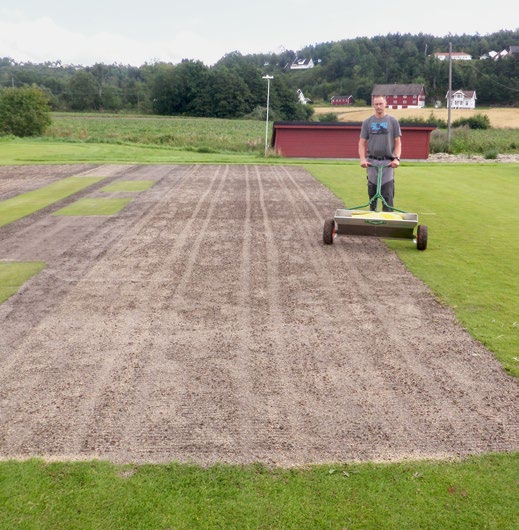
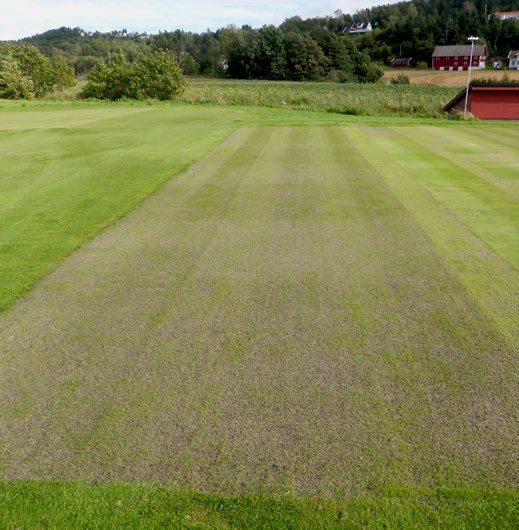
Maintenance
Fertilization: Before seeding, Binadan organic fertilizer (Binadan A/S, Nørre Snede, Denmark) was raked into the 2-3 cm surface layer at rates corresponding to 8.5 g N, 1.0 g P and 7.5 g K m-2 on the PEAT rootzone and 4.3 g N, 0.5 g P and 3.8 g K m-2 on the GM rootzone. During grow-in, all plots received alternate inputs of Wallco 5-1-4 liquid fertilizer (Cederroth International AB, Falun, Sweden) and Andersons 13-2-13 granular fertilizer (The Andersons, Maumee, Ohio, USA) at weekly intervals until 12 Sep. and subsequently at two week intervals. The fertilizer rates continued to be 50 % lower on GM rootzones than on PEAT rootzones except for the last application after growth cessation on 15 Nov. Including the preseeding application, the total amounts of N, P and K on PEAT and GM rootzones were 16.5 and 8.5 g N m-2, 2.1 and 1.1 g P m-2 and 14.2 and 7.3 g K m-2, respectively. This difference in fertilizer inputs during grow-in was set up to compensate for the higher nutrient content in the GM rootzone and provide a uniform turf cover on all plots in spring 2012.
In 2012, all plots recieved the same amount of liquid fertilizer at weekly intervals until 10 July and at two week intervals after that. The annual rates of N, P and K were 13.3, 0.64 and 10.8 g m-2, respectively.
Topdressing: The experiment was not topdressed in 2011. In 2012 the individual plots were dressed with either straight sand (SS) or GM topdress (the same sand plus finely graded composted garden waste) at two week intervals from 25 Apr. to 10 Oct. The sand was spread by hand, and the total amount applied over the season was 8.2 mm (8.2 L m-2). The topdress was supplied by Solum AS, Roskilde, Denmark and had a mean grain size of 0.43 mm and a uniformity index (D90/D10) of 3.0). Chemical analyses are given in Table 1.
Irrigation: During grow-in in 2011, the green was irrigated with 1-2 mm up to five times a day except on days with natural rainfall. In 2012, 5 mm of water was given after each input of fertilizer or topdress and 10 mm each time the volumetric soil moisture content in the upper 12 cm became lower than 10 %, as measured with a TDR probe.
Mowing: The trial was mowed with a walk-behind green’s mower three times per week and clippings collected. Mowing height during grow-in in 2011 was gradually reduced from 9 to 7 mm. In 2012, the mowing height was gradually reduced from 9 mm in late March to 5 mm on 7 May, at which height it remained for the rest of the trial.
Aeration: All plots were aereated with 6 mm solid tines to 6 cm depth on 23 April, 5 June and 14 August 2012.
Wear: From mid-July to mid October 2012 the trial it was exposed to artificial wear and compaction using a friction wear drum with golf spikes and a weight corresponding to an adult player. The total amount of wear corresponded to ca. 20.000 rounds of golf.
Registrations and statistical analyses
Recordings during grow-in from August to November 2011:
- Per cent turf coverage (all grasses) was assessed on 2 Sep., 9 Oct. and 15 Nov.
- The number of red fescue and annual bluegrass tillers were counted in samples (56 mm diameter) taken on 22 Nov.
- Per cent of roots colonized by mycorrhiza was determined in root samples (2.1 cm diameter, 20 cm deep) taken on 18 Oct. from distinct patches of red fescue and annual bluegrass in each plot. Roots were washed carefully, heated with KOH and stained. Per cent colonization was determined by the ‘grid-line intersect method’ (GIOVANETTI and MOSSE, 1980).
Recordings in 2012:
Per cent coverage of bare soil, red fescue, annual bluegrass and other grasses, turfgrass general impression (1-9, 9 is the best turf), turfgrass density (1-9, 9 is most dense) and turfgrass diseases (per cent of plot area) were assessed at monthly intervals from April to November.
- Turfgrass autumn color (1-9, 9 is the most freshly green color) was assessed three times from September to November.
- Turfgrass ball roll and surface hardness were measured four times from June to October as an indication of playing quality. The ball roll distance was measured using a short stimpmeter modified for research plots (GAUSSION et al., 1995). Measurements were always taken 24-30 hours after mowing. Green hardness was measured using a Clegg Soil Impact Tester with a 2.25 kg hammer (Lafayette Instrument Co., Indiana, USA).
- Root development was determined using an auger, 30 cm long and 5.6 cm in diameter on 4 Apr. and 18 Oct. Roots from 0-5 cm and below 5 cm soil depth were washed and dried at 60 °C for 48 hours for determination of dry weight.
- Mycorrhizal colonization was determined on 5 Jun. and 18 Oct. using the same method as in 2011. Because annual bluegrass disappeared in late summer, sampling on 18 Oct. only included red fescue.
Statistical analyses
The experimental data were analyzed using the PROC ANOVA (SAS institute, Cary, NC, USA). Throughout this article, the term ‘significant’ always refers to a probability level of P ≤ 0.05. Differences with probabilities in the range 0.05 < P ≤ 0.10 are refereed to as ‘tendencies’ or ‘trends’.
Results
Two weeks after seeding the turf coverage was significantly better on GM rootzones than on PEAT rootzones (Figure 1). Two months after seeding this effect was reversed as PEAT rootzones had slightly, although not significantly, better coverage than GM rootzones. By the end of the growing season, the number of red fescue tillers was significantly higher on PEAT rootzones that had received 16.5 g N m-2 than on GM rootzones that had received 8.5 g N m-2 (Table 2). Annual bluegrass constituted 10-20 % of the total tiller population on all plots and showed a tendency (P = 0.09) to more tillers on PEAT rootzones than on GM rootzones. The total tiller density by the end of the grow-in year was 34 % lower on GM rootzones than on peat-amended rootzones (Table 2).
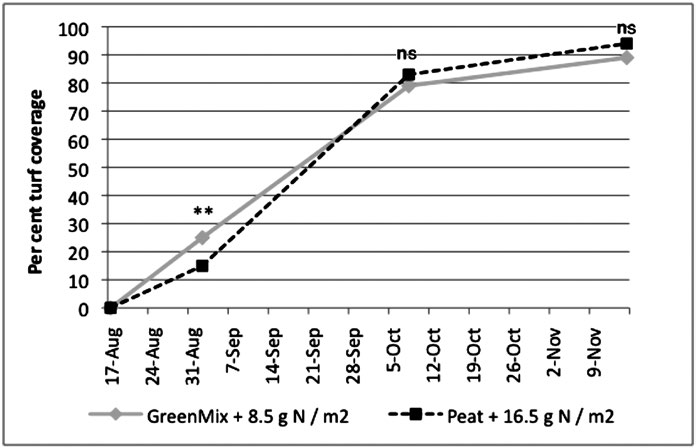
Turf coverage and botanical composition in 2012
At the first assessment in April 2012, red fescue, annual bluegrass and bare soil made up 80, 15 and 5 % of the sur face area on both rootzones (Figure 2). In May, June and July, GM rootzones had less red fescue and bare soil, but significantly more annual bluegrass than PEAT rootzones. However, regardless of rootzone, annual bluegrass was outcompeted by red fescue after 6 July 2012. A certain invasion of creeping bentgrass (A. stolonifera) occurred in autumn, significantly more on GM rootzones than on PEAT rootzones (Figure 2).
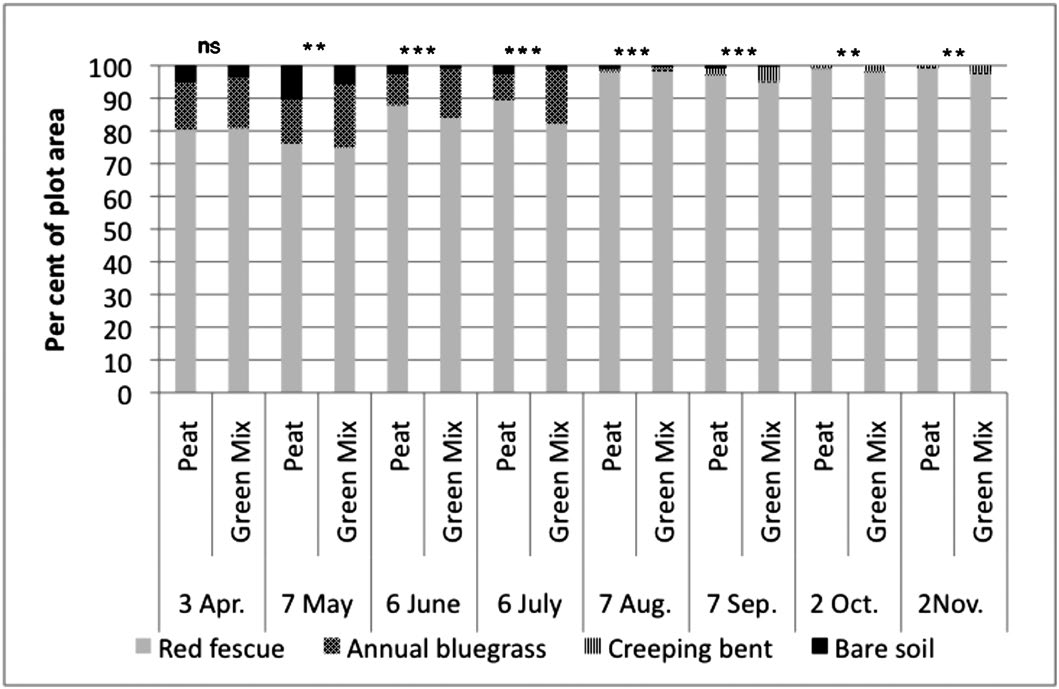
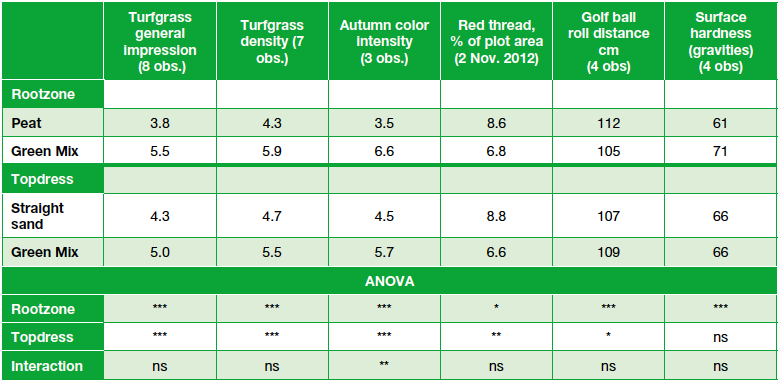
Topdressing material had no effect on per cent bare soil, red fescue or annual bluegrass on any of the observation dates, but the infestation of creeping bentgrass in autumn was exacerbated by GM topdress (data not shown in table or figure).
Turfgrass general impression, density, autumn color and diseases
GM significantly improved turfgrass general impression, tiller density and autumn color and reduced the occurrence of red thread disease (Laetisaria fuciformis), both when used in the rootzone and as topdress (Table 3, Figure 3). The positive effect of GM topdress on autumn color was more pronounced on PEAT then on GM rootzones (significant interaction in Table 3).
Playing quality
Turfgrass ball roll distance was significantly lower on GM rootzones than on PEAT rootzones (Table 3). In contrast, GM had a small, but significantly positive influence on ball roll when used as topdress. The green surfaces were significantly harder on GM rootzones than on PEAT rootzones. Type of topdress had no effect on surface hardness (Table 3).
Root development and mycorrhiza
In April 2012 there was a tendency to more roots below 5 cm in GM rootzones that had received 8.5 g N m-2 in 2011 than in PEAT rootzones that had received 16.5 g N m-2 in 2011 (Table 4). At the following observation in October, the average root dry weight in the upper 5 cm was about four times higher than in April, and for this layer there was also a tendency for root weight to be higher in PEAT rootzones than in GM rootzones (Table 4). In October there was no longer a tendency to more roots below 5 cm in GM rootzones than in PEAT rootzones.
Mycorrhizal colonization two months after seeding was low, and there was no effect of either rootzone (Table 4) or turfgrass species (not shown). On 5 June 2012, the colonization level was even lower, but now there was a significant difference as 1.3 % of the annual bluegrass roots were colonized versus 0.8 % of the red fescue roots (P = 0.013; not shown). In October 2012 colonization had increased to almost 59 % in GM rootzones versus 22 % in PEAT rootzones (Table 4).
Discussion
Because of faster establishment of putting greens on GM rootzones than on PEAT rootzones in an earlier trial (AAMLID, 2005) we decided to cut the fertilizer input during grow-in by 50 % on GM rootzones. That trial was conducted with creeping bentgrass but the present results confirm that there was an enhancement of grow-in also in red fescue. In agreement with the chemical analyses, the fact that turf coverage two weeks after seeding was better on the GM than on the PEAT rootzones shows that some of the nutrients in the compost were directly available at the seedling stage. Later during grow-in, the higher nutrient content in the GM rootzone was more than counteracted by the 50 % cut in fertilizer rate compared with the PEAT rootzone. The lower tiller density on the GM rootzone than on the PEAT rootzone by the end of the grow-in year suggests that the GM rootzone supplied less than 8.0 g N m-2 in the grow-in year and that a lower reduction would have been more appropriate.
Based on the assumption that mycorrhiza is more important for plants growing under low-fertility conditions than in cultivated systems with high inputs of N and P (READ, 1991), a surprising result was the almost three times higher colonization of red fescue roots in GM rootzones than in PEAT rootzones. Because of interactions between N and P, and also between these elements and carbon supplies from the associated plant, there are, however, many conflicting reports on the effect of increased supply of N and P on mycorrhizal colonization (e.g. TRESEDER and ALLEN, 2002; TRESEDER, 2004). In our experiment, the most likely explanations for stronger colonization in GM rootzones was that the denser and more vigorous turf provided more assimilates for the symbiotic component, and/or that the organic forms of N and P in compost did not inhibit mycorrhiza to the same extent as readily available nutrients in mineral fertilizers. These explanations are compatible with CAVENDER et al. (2003) who found that both sterile and nonsterile composts stimulated mycorrhizal colonization of roots of Sorghum bicolor. A higher initial content of mycorrhiza in GM rootzones at construction can be ruled out because propagules of the fungus were most likely killed by temperatures around 70 ºC during the composting process; this is also confirmed the very low proportion of roots colonized in autumn 2011 and spring 2012. To conclude this section, it seems that enhanced colonization with mycorrhiza is an added benefit of adding compost to sand-based rootzones.
More competition from annual bluegrass on GM rootzones than on PEAT rootzones in the spring and early summer of 2012, before any significant colonization with mycorrhiza occurred, can probably be attributed to a higher content of plant available N and P. This is in agreement with ERICSSON et al. (2013) who found fertilizer requirements of turfgrasses to decrease in the order annual bluegrass > creeping bentgrass > red fescue, and with RALEY et al. (2013) who found infestation of annual bluegrass to become more severe at increasing P levels. Along the same lines, the higher proportion of annual bluegrass tillers on the PEAT than on GM rootzone in 2011 can probaably be explained by the higher fertilizer rates given to PEAT rootzone during grow-in.
Although it is a common observation that the competition of annual bluegrass on golf greens declines with increasing temperature and decreasing rainfall from spring to summer (e.g. CLINE et al., 1993), the sudden and almost complete disappearance of annual bluegrass from early July to early August probably reflects that the annual bluegrass was a weed-type, and not a greens’ type with better persistence and adaptation to low mowing heights (VARGAS and TURGEON, 2004). At the same time, it cannot be ruled out that root colonization with mycorrhiza contributed to the demise of annual blugrass from the green during July. On greens with a mixed cover of creeping bentgrass and annual bluegrass, it has earlier been documented that inocluation of roots of both species with mycorrhiza will change the botanical compostion in favor of creeping bentgrass, and it has been speculated that this is due not only to a shift in the competition between the two species, but also to a direct antagonistic effect of mycorrhizal colonization on annual bluegrass (GANGE et al., 1999).
The effect of different topdressing materials on the young and immature green were mostly small compared with the effect of rootzone compostion. It is, however, noteworthy that a tendency to improved general impression after using GM topdress appeared as early as five weeks after the first application and that GM topdress had a clear effect on turfgrass color retention in autumn. Some of these visual effects can perhaps be interpreted as artefacts due to the darker color of the GM compared with the SS topdress, but there were also other positive aspects of using GM topdress, e.g. on disease occurrence and playing quality. Greenkeepers managing red fescue apply an average of 7 mm topdressing per year, and according to the Danish supplier of GM topdress, this corresponds to 3-4 g plant available nitrogen per m2 or about 50 % of the nitrogen requirement on established red fescue greens (KVALBEIN et al., 2012). Acknowledgement This research was funded by the Scandinavian Turfgrass and Environment Research Foundation through the project ‘FESCUE GREEN’.
References
AAMLID, T.S., 2005: Organic amendments of sand-based golf greens: Effects on establishment rate, root development, disease occurrence and nutrient leakage during the first year after sowing. International Turfgrass Society Research Journal 10, 83-84 (Annexe).
AAMLID, T.S., G. THORVALDSSON, F. ENGER and T. PETTERSEN, 2012: Turfgrass species and varieties for integrated pest management of Scandinavian putting greens. Acta Agriculturae Scandinavica Section B Soil & Plant Science 62 (Supplement 1), 10-23.
AAMLID, T.S., W. WAALEN, G. THORVALDSSON, A.M.D. JENSEN, T. ESEPVIG, T. PETTERSEN, J. TANGSVEEN, A.A. STEENSOHN, P. SøRENSEN and B. HANNESSON, 2015. SCANGREEN 2011-2014: Turfgrass species and varieties for Integrated Pest Management of Scandinavian putting Bioforsk Report 10(65), 1-91.
BOULTER, J.L., G.J. BOLAND and J.T. TREVORS, 2002: Assessment of compost for suppression of Fusarium Patch (Microdochium nivale), and Typhula blight (Typhula ishikariensis) snow molds of turfgrass. Biological Control 25, 162-172.
CAVENDER, N.D., R.M. ATIYEH and M. KNEE, 2003: Vermicompost stimulates mycorrhizal colonization of roots of Sorghum bicolor at the expense of plant growth. Pedobiologia 47, 85-89.
CLINE, V.W., D.B. WHITE and H. KAERWER, 1993: Observation of population dynamics of selected annual bluegrass-creeping bentgrass golf greens in MN. International Turfgrass Society Research Journal 7, 839- 844.
ERICSSSON, T., K. BLOMBÄCK and A. KVALBEIN, 2013: Precision fertilization – from theory to practise. www.sterf.com (Accessed 22 Feb. 2016).
GANGE, A.C., D.E. LINDSAY and L.E. ELLIS, 1999: Can arbuscular mycorrhizal fungi be used to control the undesirable grass Poa annua on golf courses? Journal of Applied Ecology 36, 909-919.
GAUSSION, R., J. NUS and L. LEUTHOLD, 1995: A modified stimpmeter for small-plot turfgrass research. HortScience 30, 547- 548.
GIOVANNETTI, M. and B. MOSSE, 1980: An evaluation of techniques for measuring vesicular arbuscuilar mycorrhizal infection on roots. New Phytologist 84, 489-500.
KVALBEIN, A., A.M.D. JENSEN, P. RASMUSSEN and T.S. AAMLID, 2012: Red fescue management. Guidelines based on greenkeepers’ experiences. www.sterf.com (Accessed 22 Feb. 2016).
NELSON, E.B. and M.J. BOEHM, 2002: Compost- induced suppression of turf grass diseases. BioCycle, The Journal of Composting & Recycling 43, 51-55.
RALEY, R.B., P.J. LANDSCHOOT and J.T. BROSNAN, 2013: Infuence of phosphorus and nitrogen on annula bluegrass encroachment in a creeping bentgrass putting green. International Turfgrass Society Research Journal 12, 649-655.
READ, D.J., 1991: Mycorrhiza in ecosystems – natur’s response to the ‘Law of minimum’. In: HAWKSWORTH, D.L. (ed). Frontiers in mycology. CAB International. 101-130.
TRESEDER, K.K., 2004: A meta-analysis of mycorrhizal responses to nitrogen, phosphorus and atmospheric CO2 in field studies. New Phytologist 164, 347-355.
TRESEDER, K.K. and M.F. ALLEN, 2002: Direct nitrogen and phosphorus limitation of arbuscular mycorrhizal fungi: a model and field test. New Phytologist 155, 507-515.
USGA GREEN SECTION STAFF, 2004. USGA recommendations for a method for putting green construction. www.usga. org/course_care/articles/construction/ greens/USGA-Recommendations-For-AMethod- Of-Putting-Green-Construction (Accessed 22 Feb. 2016).
VARGAS J.M. and A.J. TURGEON, 2004: Poa annua. Physiology, culture and control of annual bluegrass. John Wiley & Sons, Hoboken, NJ, USA.
WADDINGTON, J.M., K.D. WARNER and G.W. KENNEDY, 2002: Cutover peatlands: A persistent source of atmospheric CO2. Global Biochemical Cycles 16, 1-7.
1) Norwegian Institute for Bioeconomy Research (NIBIO), Department for Urban Greening and Environmental Engineering, Turfgrass Research Group
2) Høst A/S – Valuable Waste, Grimstad, Norway
3) Forest & Landscape, University of Copenhagen LIFE, Denmark
Author:
Dr. Trygve S. Aamlid
NIBIO Landvik, Reddalsveien 215,
NO-4886 Grimstad, Norway
E-Mail: trygve.aamlid (at) nibio.no
